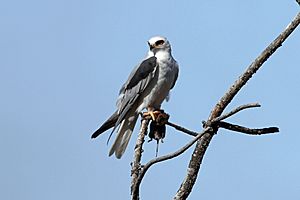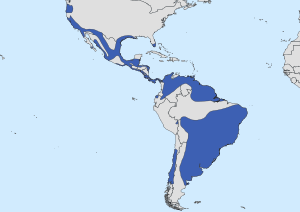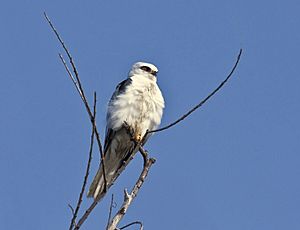White-tailed kite facts for kids
Quick facts for kids White-tailed kite |
|
|---|---|
 |
|
| White-tailed kite with prey. | |
| Conservation status | |
| Scientific classification | |
| Genus: |
Elanus
|
| Species: |
leucurus
|
| Subspecies | |
|
|
 |
|
| Synonyms | |
|
Elanus caeruleus leucurus |
|
The white-tailed kite (Elanus leucurus) is a small raptor that lives in western North America and parts of South America. These birds are known for their beautiful white feathers and amazing hunting skills. They are often seen hovering in the air, looking for their next meal.
Contents
What's in a Name?
The white-tailed kite got its scientific name in 1818 from a French bird expert named Louis Jean Pierre Vieillot. He first called it Milvus leucurus. Today, it's part of a group of birds called Elanus, a name given by another French scientist, Jules-César Savigny.
Meaning of the Name
The word Elanus comes from an Ancient Greek word meaning "kite," which is a type of bird. The second part of its name, leucurus, also comes from Ancient Greek. Leukos means "white," and oura means "tail." So, leucurus means "white-tailed," which perfectly describes this bird!
How Scientists Classify Birds
For a while, the white-tailed kite was thought to be the same species as the black-winged kite found in Europe and Africa. They were all called "black-shouldered kites." But scientists looked closer at their size, shape, feathers, and how they behaved. They found enough differences to say that the white-tailed kite is its own unique species.
Because of this, the white-tailed kite went back to its original name. The black-winged kite in Europe and Africa also got its old name back. There's even an Australian bird, Elanus axillaris, that used to be grouped with them but is now considered a separate species too. It's called the black-shouldered kite.
What Does a White-tailed Kite Look Like?
White-tailed kites look a bit like gulls because of their white color. But they fly and have a shape more like a falcon, with a rounded tail. They are mostly white underneath, with black tips on their wings and black patches on their shoulders.
Size and Weight
These kites are medium-sized birds. They are about 35–43 cm (14–17 in) (about 14 to 17 inches) long. Their wings can spread out 88–102 cm (35–40 in) (about 35 to 40 inches) wide. They weigh between 250–380 g (8.8–13.4 oz) (about 9 to 13 ounces), which is like weighing a few small apples. Both their wings and tail are quite long.
Where Do White-tailed Kites Live?
White-tailed kites were once almost gone from California in the 1930s and 1940s. This was because people were shooting them and collecting their eggs. Luckily, they are common again in many areas.
Their Habitat
You can find them in places like the Central Valley and southern coastal areas of California. They also live in open lands around Goleta, including the Ellwood Mesa Open Space, and in marshes in Humboldt County. They are also seen around the San Francisco Bay. However, they are still rare or not found in other parts of California.
Beyond California, these kites live from southern Texas and eastern Mexico all the way down through Central and South America to central Argentina and Chile.
Conservation Status
Globally, the white-tailed kite is not considered a threatened species by the IUCN. This means their numbers are healthy worldwide. Very rarely, these birds have been seen far from their usual homes, like in New England.
How Do White-tailed Kites Behave?
White-tailed kites mostly eat rodents, like mice and voles. You can often see them flying slowly or hovering over open fields and grasslands, searching for food. They almost never eat other birds. Even when they are near other birds feeding, the kites usually ignore them.
Social Life
When it's not breeding season, white-tailed kites like to gather together. They will roost (rest) in groups that can have up to 100 birds!
Territorial Fights
Sometimes, white-tailed kites will fight in the air if another kite gets too close to their territory. They might lock their talons (claws) together in a move that looks like "grappling."
Images for kids
See also
 In Spanish: Elanio maromero para niños
In Spanish: Elanio maromero para niños






